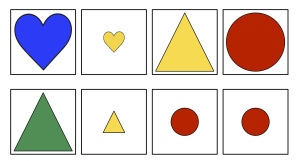All That Jazz

I’m leaving tomorrow for Chicago, to go to yet another conference. I’m a little bit conferenced-out, but I’m presenting my own research there, which makes it kind of exciting. I’m a bit excited because the conference is the Jean Piaget Society, and Jean Piaget invented cognitive developmental psychology (among other things), and I hear good things about this conference.

I’ll be presenting one of my tasks there. This is a task I literally made up one day, and then said, hey, wouldn’t it be a good task to measure cognitive flexibility in children? In this task, children see an array of cards like in the picture. Then, I ask them to give my friend Sarah (a cute Plan Toy doll) all the hearts. After we’ve done that, Sarah goes home and we put all her cards back. Then I ask them to give my friend Tommy all the yellow triangles, and after that they are asked to give my friend Kate all the small red circles. So, in order to succeed on level three (Kate’s small red circles), kids have to be able to coordinate all three dimensions - shape, colour, and size - to select the correct cards (and only the correct cards) to give to Kate.
It’s so simple that I still sometimes think I’ve missed something. The idea was to create a task that is simple to run, that even little kids can understand and do at least something, and that will give us a measure of the child’s cognitive flexibility, which, as I mentioned before, is an important skill to have. My poster shows the task, and goes into details about what this task correlates with and what it tells us. The bottom line is that my task is good because it measures preschoolers’ ability to coordinate two or more dimensions at the same time. The tasks that exist now only allow us to measure shifting between two dimensions, that is, for instance, first think about colour and then shift to thinking about shape. So, the two new things that we can measure with this task is thinking about two dimensions at the same time as opposed to one and then the other, and it allows us to look into children’s ability to think about more than two dimensions, something that so far has not been investigated.
The cool part? About half of my sample (which are 3- and 4-year-olds) were able to think about shape, colour, and size at the same time, whereas only about a third were able to shift between sorting cards first according to shape, then according to colour, and then according to size. So it is possible that this task taps into an aspect of cognitive flexibility that is, in fact, easier for kids.
Why is this interesting?
First of all, if we can measure it we can investigate it, and so far we weren’t able to measure preschoolers’ ability to coordinate three dimensions at the same time. Second, because cognitive flexibility plays a key role in problem solving and flexible behaviour, it would be really interesting to look into different aspects of this skill, when they develop, and how they relate to other skills (I’m focusing mostly on executive functions - inhibitory control and working memory). And the ultimate goal would be to help children who lag behind. For example, cognitive flexibility is related to school readiness and academic success. If we can identify children with lower cognitive flexibility skills when they are three years old, and we know how to help them overcome those deficits, and hopefully that would make the gap smaller by the time they get to school. And wouldn’t that be awesome??
